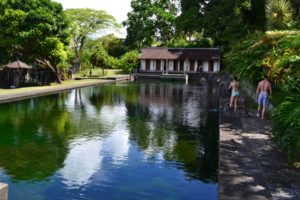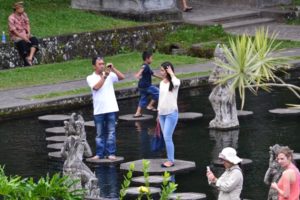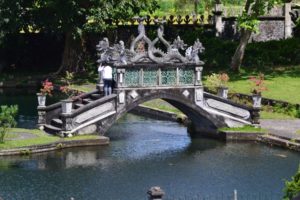Tirtanganga Water Palace
Tirtanganga Water Palace
The water from one of the natural springs of Tirtagangga has always been regarded as holy. It is used for religious ceremonies in the temples in the area until today. Tirta means blessed water, gangga cames from Ganges, the holy river in India.
The holy water is required for ceremonies of the temples in the surrounding as far as Tirtagangga can be reached by foot. At certain celebration days the people from the villages around will come in colourful processions with offerings, umbrellas, flags and other attributes. Led by their temple priest they hold ceremonies around the spring under the sounds of hymns and the music of the beleganjur. The springs have a huge output of pure water.
The water is first led to a reservoir where it is divided in two parts. One third provides drinking water for the City of Amlapura. The remainder goes into the upper swimming pool through an underground pipe. The overflow of water goes into the lower swimming pool, the other ponds and finally to the rice fields.
 TIP.: Take your swimmers. The water is said to be healing. Small fee apply for upkeep of pool.
TIP.: Take your swimmers. The water is said to be healing. Small fee apply for upkeep of pool.
There is a healing pool is open for visitors to swim and spend time in the pool. The waters are crystal clear and come directly from the underground steam. There is a small charge for the upkeep of the pool. After swimming you may like some lunch in the Restaurant overlooking the Water Palace that is Tirtagangga. The restaurant has an international chef and wines. Entry into Tirtagangga is donation of approximately 60,000
WHAT IS TIRTAGANGGA
Tirtagangga royal water garden is composed mainly by water, plants and sculptures. It is situated in the middle of rice fields around the natural springs of Rejasa, approximately 7 km. (5 miles) north of Amlapura, the main town of east Bali, Indonesia.
Tirtagangga is a well-known cultural object of Bali. It belongs to the royal family of Karangasem.
The area of the water garden is about 1.2 ha (3 acres), consisting of three levels of ground stretching from east to west. On the highest northern Swah level there are the spring under the Banyan tree, the upper swimming pool and two decorative ponds, one with four fountains reminiscent of Versailles, and the other with Victoria lotuses.
The first thing one sees when entering the garden is the elegant eleven-tiered Nawa Sanga fountain which rises from the middle of the complex. This fountain together with the two ponds form the middle Bwah level.
The larger lowest Bhur level, on the left side of the straight foot path running from the entrance to the west, is occupied by the big South pond with the long Demon island in the middle.
The water from one of the natural springs of Tirtagangga has always been regarded as holy. It is used for religious ceremonies in the temples in the area until today. Tirta means blessed water, gangga cames from Ganges, the holy river in India. The holy water is required for ceremonies of the temples in the surrounding as far as Tirtagangga can be reached by foot.
At certain celebration days the people from the villages around will come in colourful processions with offerings, umbrellas, flags and other attributes. Led by their temple priest they hold ceremonies around the spring under the sounds of hymns and the music of the beleganjur.
The springs have a huge output of pure water. The water is first led to a reservoir where it is divided in two parts. One third provides drinking water for the town Amlapura. The remainder goes into the upper swimming pool through an underground pipe. The overflow of water goes into the lower swimming pool, the other ponds and finally to the rice fields.
No trip to Tirtagangga is complete without lunch in the Kings Restaurant.
Ask made about Tour Cost.Lunch is additional.


